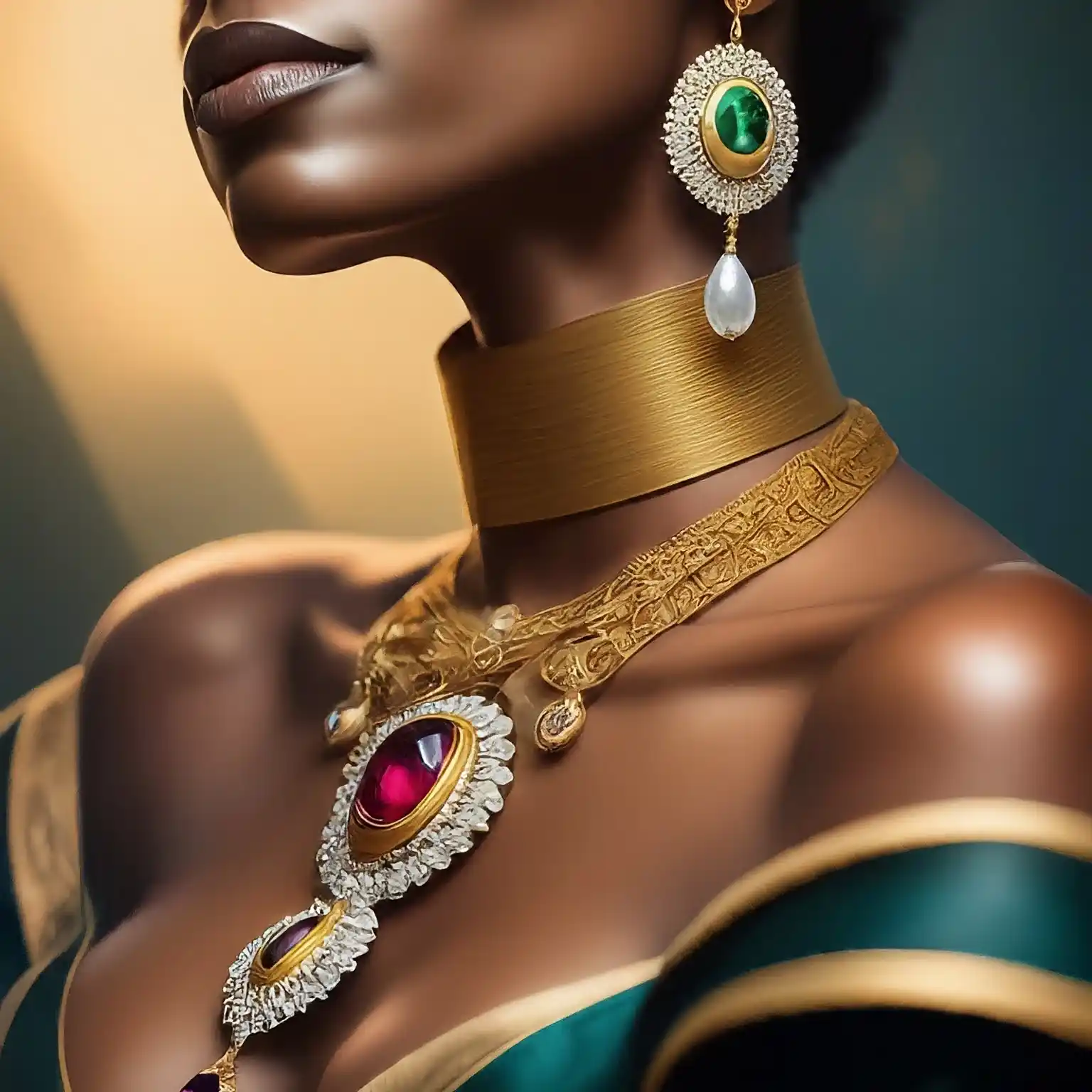
- Jewelry Market
Regional Jewelry Traditions: A Journey Through Unique Cultural Expressions
Table of Contents
Jewelry has been an integral part of human culture for thousands of years, reflecting both artistic expression and societal values. Around the world, regions have developed unique jewelry traditions that symbolize everything from status and wealth to spirituality and beauty. Each piece of jewelry tells a story—whether it’s the intricate gold designs of India, the tribal adornments of Africa, or the minimalist elegance of Scandinavian regions. Let’s explore some of the most distinct jewelry traditions from various regions of the world.
1. Indian Jewelry: An Embodiment of Tradition and Spirituality
India is one of the world’s richest regions in terms of jewelry tradition, boasting a heritage that spans millennia. From ornate necklaces to heavy earrings, jewelry in India is deeply symbolic and is often associated with religious and cultural practices.
Kundan and Meenakari
Two of the most recognizable Indian jewelry styles are Kundan and Meenakari, both often seen in royal settings. Kundan involves intricate gold work in which precious stones are set. This technique, dating back to the Mughal era, is celebrated for its elegance and grandeur.
Meenakari, on the other hand, focuses on enamel work. Originating from Rajasthan, this technique involves filling grooves in jewelry with vivid colors to create beautiful, multi-hued designs. Wedding ceremonies in India often feature brides adorned in Kundan jewelry, rich with emeralds, rubies, and diamonds, while their saris shimmer with matching Meenakari ornaments.
Gold as a Symbol of Wealth
In southern India, gold jewelry is the most prized, as it symbolizes wealth and prosperity. During festivals like Diwali or weddings, it’s customary to gift gold, making it not only a personal adornment but also a financial asset.
Cultural and Religious Significance
Jewelry in India is not only decorative but also has spiritual significance. For instance, the “mangalsutra” is a necklace that married Hindu women wear as a symbol of their marital status. Bangles, nose rings, and anklets also have specific meanings, often associated with fertility, protection from evil spirits, and good fortune.
2. African Tribal Jewelry: A Connection to Nature and Identity
African jewelry traditions are closely linked to nature, with materials like bone, ivory, wood, and precious metals playing a significant role in creating unique tribal adornments. African jewelry is often more than just an accessory; it is a marker of identity, social status, and cultural beliefs.
Beadwork and Color Symbolism
In many African tribes, beadwork holds significant cultural meaning. For example, the Maasai people of Kenya and Tanzania use brightly colored beads to craft necklaces, bracelets, and earrings. Each color of bead has its symbolism: red represents bravery, blue symbolizes energy and sky, and green stands for fertility. Maasai women often wear multiple beaded collars layered around their necks, especially during important ceremonies such as weddings or tribal dances.
Brass and Copper Jewelry in West Africa
In countries like Nigeria and Ghana, brass and copper jewelry is highly valued. The Ashanti tribe in Ghana is known for their intricate gold jewelry, especially “krobo” beads, which are made from crushed glass and are believed to carry spiritual meaning. Meanwhile, the Benin Bronzes of Nigeria, crafted from bronze and brass, were historically worn by royalty and signified power and leadership.
Adornment and Rituals
African jewelry is also used in various rites of passage. For example, the Himba people of Namibia create elaborate headpieces and anklets that signify age, marital status, and social standing. Jewelry worn during these ceremonies is believed to provide spiritual protection and reflect a deep connection to ancestors.
3. Middle Eastern Jewelry: The Luxury of Gold and Gemstones
The Middle East has a long-standing tradition of crafting luxurious and ornate jewelry, often featuring gold and precious gemstones. Jewelry from this region is known for its intricate designs, often incorporating geometric patterns and natural motifs.
Traditional Gold Jewelry
In countries like Saudi Arabia, the United Arab Emirates, and Egypt, gold is the most cherished metal, symbolizing wealth, status, and religious devotion. Women wear heavy gold necklaces, bangles, and earrings, especially during weddings and festive occasions. The “harem ring,” a multi-band gold ring, and the “khanjar” dagger, an ornamental piece worn as a necklace, are examples of Middle Eastern jewelry that have historic and cultural significance.
Gemstones and Amulets
Turquoise, lapis lazuli, and pearls are frequently used in Middle Eastern jewelry. These gemstones are believed to offer protection and ward off evil spirits. Amulets in the form of the “Hand of Fatima” or “Hamsa,” a palm-shaped talisman, are also commonly worn to safeguard against bad luck.
Cultural Impact of Islamic Art
Islamic influence can be seen in the design motifs of Middle Eastern jewelry. The use of intricate geometric patterns, floral designs, and calligraphy reflects the region’s artistic traditions. Jewelry is often passed down from generation to generation, serving as both an heirloom and a marker of family heritage.
4. European Jewelry: From Renaissance Opulence to Scandinavian Simplicity
European jewelry traditions are diverse, with each country contributing its distinct styles influenced by its historical, artistic, and cultural movements.
Renaissance Jewelry
During the Renaissance, jewelry in Europe was opulent and often designed to display wealth and status. Monarchs and the aristocracy adorned themselves with gold and gemstones such as emeralds, rubies, and diamonds. Pieces were often designed in the shape of animals, flowers, or religious symbols. Elizabethan England, for example, saw pearls as the ultimate symbol of purity, and Queen Elizabeth I famously adorned herself in pearls for many portraits.
Scandinavian Simplicity
In contrast, Scandinavian jewelry is known for its minimalist and functional designs. Countries like Sweden, Denmark, and Norway favor simple, clean lines and a focus on craftsmanship. Silver is the dominant metal, often paired with amber—a gemstone native to the region. Viking heritage has also left its mark, with many modern designs inspired by the simple, functional metalwork of ancient Scandinavian warriors. Viking rings and brooches are recreated today as tributes to this rich history.
Art Nouveau and Art Deco Movements
The Art Nouveau movement in the late 19th century revolutionized European jewelry design with its organic forms, inspired by nature. Jewelry became more expressive, and pieces featured flowing lines, floral motifs, and the use of new materials such as enamel.
Later, the Art Deco movement of the 1920s embraced a more geometric, symmetrical approach, with diamonds and sapphires set in platinum becoming the hallmarks of the era. These distinct artistic styles continue to influence modern European jewelry designers.
5. Chinese Jewelry: A Legacy of Jade and Symbolism
Chinese jewelry is steeped in cultural significance, with jade being the most revered material. Known as the “Stone of Heaven,” jade is considered to embody purity, protection, and good fortune. The Chinese have used jade for more than 5,000 years to create ornaments, amulets, and ceremonial pieces.
Jade Jewelry
Jade bracelets, pendants, and rings are worn by both men and women, often as protective talismans. It is common for a jade piece to be handed down as a family heirloom, believed to bring harmony and balance to the wearer. Dragons, phoenixes, and other mythical creatures are frequently carved into jade jewelry, each symbol carrying its distinct meaning.
Gold and Filigree
Gold jewelry is also prominent in China, especially during traditional celebrations such as the Lunar New Year and weddings. Chinese goldsmiths are known for their expertise in filigree work, where fine gold threads are twisted and shaped into intricate designs. The phoenix and dragon, symbols of the emperor and empress, are popular motifs in Chinese bridal jewelry, representing balance and harmony in marriage.
Cultural Significance
Chinese jewelry often carries deep meanings related to health, wealth, and longevity. For example, the “longevity lock” is a pendant worn by children to ensure long life and protection from evil spirits.
6. Native American Jewelry: A Deep Connection to the Earth
Native American jewelry is recognized for its use of natural materials and symbolism that reflects a connection to the earth, sky, and spirits. Turquoise is a dominant gemstone in Native American jewelry, particularly in the Southwestern United States, where tribes like the Navajo, Hopi, and Zuni create stunning pieces with silver and turquoise.
Turquoise and Silverwork
Turquoise is considered a sacred stone, symbolizing health, protection, and life. Navajo silversmiths are famous for their craftsmanship in working silver into rings, bracelets, and necklaces inlaid with turquoise. The squash blossom necklace, with its large, crescent-shaped pendant known as the “naja,” is one of the most iconic forms of Native American jewelry.
Beadwork and Symbolism
Many Native American tribes also specialize in intricate beadwork, often using glass beads in bold patterns and colors. These beaded pieces serve as cultural symbols, representing various aspects of tribal identity, history, and spiritual beliefs. Feathers, bones, and shells are also incorporated into designs to represent animals and nature.
Conclusion: Celebrating Diversity Through Jewelry
Jewelry traditions from different regions of the world offer a fascinating glimpse into human culture, history, and art. From the opulent gold and gemstones of India to the minimalist designs of Scandinavia, each tradition reflects unique cultural values and artistic expressions. Whether worn for beauty, spiritual significance, or social status, jewelry continues to be a universal form of personal expression. These traditions, passed down through generations, not only connect people to their heritage but also inspire new interpretations in the modern world.
Related Posts


Jewelry and Social Status: A Historical Exploration of Wealth and Power
Fall in Love with Jewelry, Stories, and Secrets
Join Artemies Magazine for insider jewelry tips, trend updates, and subscriber-only discounts.

